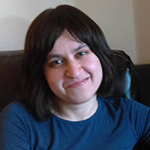No Records Found
Sorry, no records were found. Please adjust your search criteria and try again.
Google Map Not Loaded
Sorry, unable to load Google Maps API.
- Aleksandra
- Brodskaya
- No
- 7317 Greenhill Road
Philadelphia
Pennsylvania
19151
United States - Inventive SLP

Philadelphia
Pennsylvania
19151
United States
After I do the evaluation and dynamic assessment, I look at what the child can do and can produce: what syllable types, how many syllables, and what consonants and vowels they can produce. Ideally, I begin with the consonants and vowels they could both produce spontaneously and in imitation. These are the sounds I will need to use to come up with my list of useful of functional words and phrases. I talk with the parent about the child's interests, life, and we come up with a list of words and phrases together that would be most helpful. For those words or phrases that would be too difficult at the time, we can consider low-tech AAC like a communication board or book with pictures or an AAC device. For those words and phrases we believe the child can produce with cueing as support, we obviously begin with those. The words and phrases should have the sounds the child can do but would probably include syllable shapes that the child has not yet mastered. We might also consider slowly introducing new sounds into our functional words/phrases list but making sure that all the other sounds in target words are sounds the child has been able to produce.
The most important to plan and consider is the level of cueing for each target. We might begin by trying to get the child to imitate what I say but if that is too hard, we need to say the word together at the same time. I need to use cues to have the child look at my face and mouth on how to say the word. I may need to have us say the word slowly together with stretched vowels (but smoothly, no pausing) if this is still too hard for the child. I need to use and continue to figure out which cues work the best for the child: certain visual cues, tactile or touch, gestures, etc.). When the child can say the word or target with me, I would then say it more quietly with the child and then just mouth it as the cue while the child says it. This way we work our way up to true imitation. When the child can imitate the word or target I say, we build off of that by doing a lot of practice or drill as we call it with the target and then do delayed imitation where I wait a moment or so and then the child imitates me. We practice saying the word as naturally as possible in this process and with different intonation or tone (like a question, exclamation, etc.) and a normal rate. After this, the child can work on using the word or target spontaneously in response to what I say. All throughout we are repeating the target over and over again to get lots of practice. I show and teach parents the cues I used for the targets so they can practice it at home once the child is proficient and more independent with it. We can also build on our target words by adding other words or combining 2 targets to make useful phrases the child can practice.
I collaborate with parents on functional words to target in the session and would then consult with families on what activities to do at home to reinforce the target that we are working on. In private therapy, I invite the parent to participate in sessions; however, parents who do not feel comfortable doing so can at least observe and note the types of cues used to elicit goals.
I have trialed devices through Pattan and then submitted devices for insurance approval for students with severe verbal apraxia. I have used Proloque devices, Touchchat, and LAMP. I have provided pictures from programs like Boardmaker to the child, his/her teachers, and families so the child can communicate their wants and needs when speech is highly unintelligible. Communication books and boards are resources I often use especially with younger children so they have a means of communicating in addition to verbal language.




